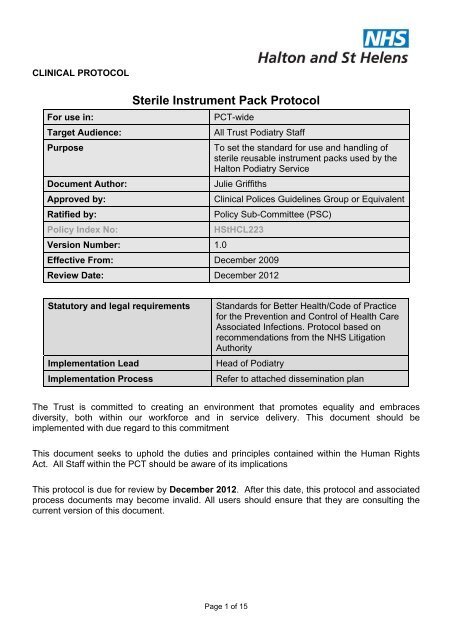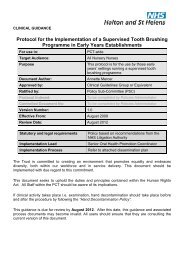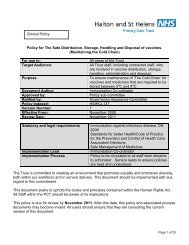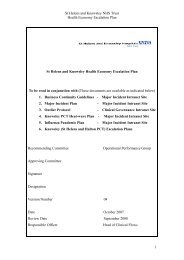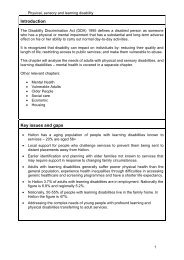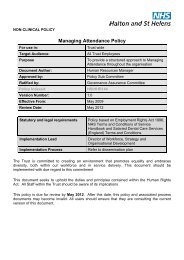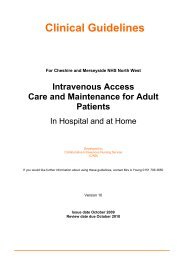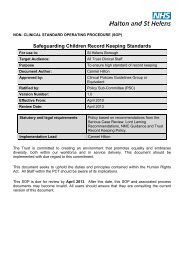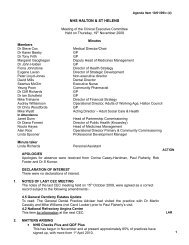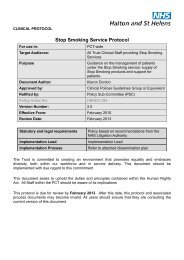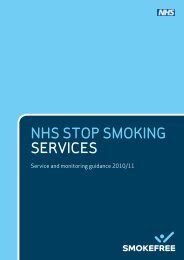CLINICAL PROTOCOL - Halton and St Helens PCT
CLINICAL PROTOCOL - Halton and St Helens PCT
CLINICAL PROTOCOL - Halton and St Helens PCT
You also want an ePaper? Increase the reach of your titles
YUMPU automatically turns print PDFs into web optimized ePapers that Google loves.
<strong>CLINICAL</strong> <strong>PROTOCOL</strong><br />
For use in:<br />
Target Audience:<br />
Purpose<br />
Document Author:<br />
Approved by:<br />
Ratified by:<br />
Policy Index No:<br />
<strong>St</strong>erile Instrument Pack Protocol<br />
Version Number: 1.0<br />
<strong>PCT</strong>-wide<br />
All Trust Podiatry <strong>St</strong>aff<br />
To set the st<strong>and</strong>ard for use <strong>and</strong> h<strong>and</strong>ling of<br />
sterile reusable instrument packs used by the<br />
<strong>Halton</strong> Podiatry Service<br />
Julie Griffiths<br />
Clinical Polices Guidelines Group or Equivalent<br />
Policy Sub-Committee (PSC)<br />
H<strong>St</strong>HCL223<br />
Effective From: December 2009<br />
Review Date: December 2012<br />
<strong>St</strong>atutory <strong>and</strong> legal requirements<br />
Implementation Lead<br />
Implementation Process<br />
<strong>St</strong><strong>and</strong>ards for Better Health/Code of Practice<br />
for the Prevention <strong>and</strong> Control of Health Care<br />
Associated Infections. Protocol based on<br />
recommendations from the NHS Litigation<br />
Authority<br />
Head of Podiatry<br />
Refer to attached dissemination plan<br />
The Trust is committed to creating an environment that promotes equality <strong>and</strong> embraces<br />
diversity, both within our workforce <strong>and</strong> in service delivery. This document should be<br />
implemented with due regard to this commitment<br />
This document seeks to uphold the duties <strong>and</strong> principles contained within the Human Rights<br />
Act. All <strong>St</strong>aff within the <strong>PCT</strong> should be aware of its implications<br />
This protocol is due for review by December 2012. After this date, this protocol <strong>and</strong> associated<br />
process documents may become invalid. All users should ensure that they are consulting the<br />
current version of this document.<br />
Page 1 of 15
Key individuals involved in developing the document (Internal <strong>St</strong>aff Only)<br />
Name(s)<br />
Designation<br />
Julie Griffiths<br />
Andrew Lythgoe<br />
Podiatry Manager<br />
Podiatry Team Leader<br />
Distributed to the following for approvals <strong>and</strong> comments<br />
Committee(s)<br />
Members of the Policy Sub Committee (PSC)<br />
Members of the Clinical Policies Guidelines<br />
Group (CPG)<br />
All Members of <strong>Halton</strong> Podiatry Team<br />
Page 2 of 15
Table of Contents<br />
Rationale......................................................................................................................................4<br />
Protocol <strong>St</strong>eps..............................................................................................................................5<br />
References.................................................................................................................................10<br />
Appendix 1 .................................................................................................................................11<br />
Appendix 2 .................................................................................................................................12<br />
Appendix 3 .................................................................................................................................13<br />
Appendix 4 .................................................................................................................................14<br />
Page 3 of 15
RATIONALE<br />
The rationale of this protocol is to document the Podiatry department’s procedure for the<br />
h<strong>and</strong>ling of podiatry instruments to ensure that all reasonable steps are taken to reduce the risk<br />
of cross infection during podiatry treatment through contact with podiatry instruments.<br />
This protocol should be read in conjunction with the Trust’s Policy Prevention <strong>and</strong> Management<br />
of Occupational Health Exposure to BBV <strong>and</strong> Prevention of Sharps Injuries, on the Document<br />
Portal, <strong>and</strong> Infection Prevention <strong>and</strong> Control Policy No.27 Aseptic Technique<br />
The Podiatry Department uses both reusable <strong>and</strong> disposable instruments in order to carry out<br />
podiatry treatments.<br />
The Countess of Chester Hospital (COCH) decontaminates the department’s reusable<br />
instruments to the st<strong>and</strong>ard HTM2010.<br />
Decontaminated reusable instruments are supplied as sets of multiple instruments <strong>and</strong> single<br />
instruments (Refer to Appendix 1) in sterile packaging.<br />
Disposable instruments are supplied as individual instruments in sterile packaging.<br />
The majority of podiatry treatments will be undertaken using a basic pack of reusable<br />
instruments. However at times it will be clinically appropriate to supplement these packs from<br />
the range of single wrapped reusable <strong>and</strong> disposable instruments.<br />
For nail surgery <strong>and</strong> local anaesthetic procedures separate packs are available.<br />
All podiatry treatments must be carried out using authorised podiatry instruments as supplied in<br />
their sterile state.<br />
No other instrumentation may be used than those authorised <strong>and</strong> supplied by the department.<br />
It is each individual staff member’s responsibility to ensure that they fully follow this protocol.<br />
All new podiatry staff as part of their induction will be given training on this protocol.<br />
Page 4 of 15
<strong>PROTOCOL</strong> STEPS<br />
<strong>St</strong>eps<br />
1. <strong>St</strong>orage of instruments<br />
Reusable instruments are transported to <strong>and</strong> from COCH in bespoke (Blue) transportation<br />
boxes.<br />
Fast transport will deliver processed clean instruments <strong>and</strong> remove dirty instruments from<br />
each podiatry site, on a 48 hour turnaround.<br />
Clean instruments must be stored separately from dirty instruments. Areas have been<br />
designated for the segregated storage of clean <strong>and</strong> dirty instruments at each podiatry site<br />
Clean disposable instruments, must be stored in the designated clean areas.<br />
Podiatry staff whilst undertaking domiciliary visits should store clean <strong>and</strong> dirty instrument<br />
sets separately. A carried bag inside a second carry bag is sufficient to keep dirty<br />
instrument sets separate from the podiatrist’s / podiatry assistants visiting bag <strong>and</strong> clean<br />
instrument sets.<br />
2. Checking Supplies<br />
The Black tie should be removed with a pair of scissors. Podiatry staff should then check<br />
the boxes’ contents against the delivery note, which is inside each box of clean<br />
instruments.<br />
If there are any discrepancies between the delivery note <strong>and</strong> the box contents, these<br />
should be noted on the delivery note, the note then photocopied prior to storing it in the<br />
file. The photocopy of the delivery note should then be forwarded to the line manager for<br />
monitoring.<br />
Clean packs of instruments should be transferred to the treatment area as required.<br />
3. Use of Instruments<br />
Examining the Packaging<br />
Reusable instruments<br />
The podiatrist / podiatry assistant should ensure that they select the appropriate<br />
instrumentation prior to commencing treatment. The packaging should be examined to<br />
ensure that it is intact.<br />
Any instruments sets with damaged packaging must not be used. The contents list should<br />
be removed from the packaging <strong>and</strong> note made to describe the way in which the<br />
packaging is damaged. The contents list should be signed <strong>and</strong> returned to the packaging.<br />
The set should then be returned to the processing company as a dirty set<br />
Page 5 of 15
Disposable instruments<br />
The podiatrist / podiatry assistant should ensure that they select the appropriate<br />
instrumentation prior to commencing treatment. The packaging should be examined to<br />
ensure that it is intact.<br />
Any instruments with damaged packaging must not be used.<br />
The instrument should be disposed of in the instrument sharps bin.<br />
The packaging should be disposed of in the domestic waste.<br />
Prior to treatment<br />
The instruments / sets should be placed in the treatment field.<br />
The podiatrist / podiatry assistant will then open the sterile packaging.<br />
H<strong>and</strong>s then must be washed, prior to treating the patient, before the contents of the pack<br />
are removed.<br />
The podiatrist / podiatry assistant will then visually check the packs contents against the<br />
content list to establish if the all instrumentation is as stated.<br />
If any instruments are missing the podiatrist / podiatry assistant will make a clinical<br />
decision as to whether there are sufficient instruments to undertake the treatment<br />
required.<br />
If it is decided that the pack contents are insufficient, the contents list should be removed<br />
from the packaging <strong>and</strong> note made as to which instruments are missing. The contents list<br />
should be signed <strong>and</strong> returned to the packaging.<br />
The set should then be returned to COCH as a dirty set<br />
The podiatrist / podiatry assistant will then repeat the procedure with a new set.<br />
Following treatment<br />
After washing their h<strong>and</strong>s the podiatrist/ podiatry assistant should apply one of the<br />
barcode stickers from the reusable instrument set after completing the patient’s notes <strong>and</strong><br />
before signing the record. If more that one set of reusable instruments or single wrapped<br />
reusable instruments have been used then a sticker from each individual pack must be<br />
applied. The second barcode should be stuck to the day sheet next to the patient<br />
undergoing the treatment<br />
Page 6 of 15
Disposable instruments do not have tracking barcodes as they are disposed of after use.<br />
The podiatrist / podiatry technician, should then tick the content list on the pre op<br />
box to confirm that all instruments were present, <strong>and</strong> sign to say that all the<br />
instruments are being returned <strong>and</strong> that all scalpel blades have been removed on<br />
the separate section.<br />
Lubrication of nipper hinges using dental aerosol lubrication is at the discretion of<br />
practitioner.<br />
The instruments <strong>and</strong> tray must be placed in the supplied return bag. Podiatry staff should<br />
not undertake any pre cleaning of instruments.<br />
The content list should then be placed in the return bag.<br />
The return bag should be securely folded over <strong>and</strong> placed in a transit box. Note this<br />
transit box must only be used for dirty instruments.<br />
Once the transit box is full to the acceptable level (no more than 25 sets), the box should<br />
be closed <strong>and</strong> secured with another black tag, the box should then be transferred to the<br />
dirty instrument storage area.<br />
The sterile field <strong>and</strong> outside bag should be placed in the domestic waste.<br />
4. Quality Issues<br />
Reusable instruments<br />
Quality issues fall into 2 categories.<br />
1. Problems with the quality of the instrument – e.g. it is broken; nail nippers stiff,<br />
broken springs, cutting edge may become worn, shaft of bur bent. These may be<br />
identified on opening a pack. However in many cases it is not until the instrument<br />
is used the problem is identified. The podiatrist / podiatry assistant should<br />
document on the contents list a description of the problem <strong>and</strong> any action required<br />
to remedy, e.g. replacement. Lubrication of nipper hinges using dental aerosol<br />
lubrication is at the discretion of practitioner.<br />
The podiatrist / podiatry assistant will make a clinical decision to determine if the<br />
remaining instruments are sufficient to continue treatment. If not then a new pack<br />
should be opened.<br />
2. Quality issues with the decontamination process e.g. dirty, foreign body present,<br />
adhesive from podiatry products present. No part of the instrument pack must be<br />
used under any circumstances. The pack should be isolated <strong>and</strong> not returned to<br />
Page 7 of 15
processing company until this has been reported to <strong>and</strong> return authorised by the<br />
line manager. The manager will complete the incident reporting.<br />
Disposable instruments<br />
If the quality of the instrument as supplied is a cause for concern the product log number<br />
should be recorded. If the instrument has not been used then it should be kept for<br />
inspection by the line manager, if the instrument has been used then the instrument must<br />
be disposed of <strong>and</strong> the product log number <strong>and</strong> a description of the fault should be<br />
reported to the line manager.<br />
5. Scalpel Blades<br />
Podiatry scalpel h<strong>and</strong>les are supplied as reusable instruments in the basic sets.<br />
There is one scalpel in each basic set.<br />
If multiple blades are required for one treatment, that have not come into contact with<br />
body fluids (blood, pus), then the podiatrist should change the blade using a single use<br />
surgical blade remover this should then be immediately disposed of in the sharps bin.<br />
The podiatrist can then continue to use the scalpel with the new blade.<br />
For treatments in clinic, once the treatment is complete then the blade should be removed<br />
using a sharps bin with an integral blade remover (as this is the most cost effective<br />
method).<br />
For treatments in patient’s own homes, hospitals etc all blades must be removed using a<br />
single use surgical blade remover this should then be immediately disposed of in the<br />
sharps bin.<br />
If the scalpel blade has been in contact body fluids e.g. blood, pus or used for wound<br />
debridement. The blade must be immediately removed using a sharps bin with an integral<br />
blade remover if in clinic or with a single use surgical blade remover if this type of sharps<br />
bin is not available.<br />
The podiatrist must not continue to use this h<strong>and</strong>le; it should be isolated with its set of<br />
instruments <strong>and</strong> returned as dirty instruments.<br />
If a scalpel is required to continue treatment a new instrument set must be used.<br />
It is the podiatrist’s responsibility to check scalpel h<strong>and</strong>les prior to returning<br />
instrument sets to the processing company to ensure that no blades are left on the<br />
h<strong>and</strong>les. When initialling the contents list prior to the sets return the podiatrist is<br />
verifying that all blades are removed. This process will be monitored via returns<br />
from COCH; repeated breaches, following incident reports will be dealt with under<br />
the Trust’s Disciplinary Procedure.<br />
Page 8 of 15
6. Instruments Contaminated with Body Fluid<br />
Reusable instruments e.g. nail nippers, which are contaminated with body fluid during<br />
treatments must be immediately isolated from the set being used. If the type of<br />
instrument, which was contaminated, is not required to complete the treatment then the<br />
remaining instruments in the set may continue to be used.<br />
If the type of instrument, which was contaminated, is required then a new set of<br />
instruments must be used.<br />
Disposable instruments e.g. nail files, which are contaminated with body fluid during<br />
treatments must be immediately disposed of in clinical waste.<br />
7. Disposable Nail Files<br />
Disposable nail files are routinely used for treatments. If following treatment the file is in<br />
good order <strong>and</strong> has not been in contact with any body fluid or mycotic infection, this can<br />
be offered to the individual patient, to support their self-care.<br />
Nail files which have not been contaminated with body fluids <strong>and</strong> which are not given to<br />
individual patients following treatment should be disposed of in domestic waste.<br />
Nail files which have been contaminated with body fluids should be disposed of in clinical<br />
waste.<br />
8. Packs Returned from (COCH) with Scalpel Blades in Place.<br />
(COCH) are not responsible for removing any scalpel blades returned on h<strong>and</strong>les. They<br />
may return the pack in a separate transit box, which is clearly identifiable as a hazard.<br />
It is the responsibility of the podiatry department to remove such blades. Only podiatrist<br />
should remove these blades.<br />
The pack should be placed on a flat surface. A pair of scissors should be used to cut the<br />
bag at the top to expose the contents. Once the scalpel h<strong>and</strong>le is fully visible, the<br />
podiatrist may then pick it up <strong>and</strong> remove the blade with using a sharps bin with an<br />
integral blade remover.<br />
The set of instruments must then be returned as a dirty set.<br />
Page 9 of 15
REFERENCES<br />
Reference<br />
DH, Code of Practice for the Prevention<br />
<strong>and</strong> Control of Healthcare associated<br />
Infection (2008)<br />
National Institute for Clinical Excellence<br />
(2003) Clinical Guideline-Infection Control<br />
Relevance (whole document<br />
or section, please state)<br />
Whole<br />
Whole<br />
Evidence<br />
Grade<br />
Code of<br />
Practice<br />
Nice Guideline<br />
Page 10 of 15
APPENDIX 1<br />
Nail Surgery Pack:-<br />
Scalpel h<strong>and</strong>le No 3<br />
Dressing scissors<br />
Dental syringe<br />
Dental syringe (black plastic)<br />
Lock elevator<br />
Elevator small<br />
Beaver blade h<strong>and</strong>le<br />
Tube gauze applicator small<br />
Tube gauze applicator large<br />
Blacks file<br />
Mosquito forceps fine<br />
Mosquito forceps med<br />
Mosquito forceps wide<br />
Thwaites nippers<br />
Tourniquet blue / green / orange<br />
Dressing Pack:-<br />
Scalpel h<strong>and</strong>le No 3<br />
Dressing scissors<br />
Mosquito forceps fine<br />
Routine Treatment Pack:-<br />
Scalpel h<strong>and</strong>le No 3<br />
Dressing scissors<br />
Blacks file<br />
Diamond file<br />
Nail nippers<br />
Single Instrument Pack:-<br />
Scalpel h<strong>and</strong>le No 3<br />
In growing toe nail nippers<br />
Extra fine blacks file<br />
Beaver blade h<strong>and</strong>le<br />
Diamond burr<br />
Tube gauze applicator small<br />
Tube gauze applicator large<br />
Page 11 of 15
APPENDIX 2<br />
EQUALITY IMPACT ASSESSMENT TOOL<br />
To be completed with the corporate document when submitted to the appropriate committee for<br />
consideration, approval <strong>and</strong> ratification.<br />
1. Does the corporate document affect one group<br />
less or more favourably than another on the basis<br />
of:<br />
Race no<br />
Ethnic origins (including gypsies <strong>and</strong> travellers) no<br />
Nationality no<br />
Gender no<br />
Culture no<br />
Religion or belief no<br />
<br />
Sexual orientation including lesbian, gay <strong>and</strong><br />
bisexual people<br />
Age no<br />
<br />
Disability - learning disabilities, physical disability,<br />
sensory impairment <strong>and</strong> mental health problems<br />
2. Is there any evidence that some groups are<br />
affected differently?<br />
3. If you have identified potential discrimination, are<br />
there any exceptions valid, legal <strong>and</strong>/or<br />
justifiable?<br />
4. Is the impact of the policy/guidance likely to be<br />
negative?<br />
5. If so can the impact be avoided? n/a<br />
6. What alternatives are there to achieving the<br />
policy/guidance without the impact?<br />
7. Can we reduce the impact by taking different<br />
action?<br />
no<br />
no<br />
no<br />
n/a<br />
no<br />
n/a<br />
n/a<br />
Comments<br />
If you have identified a potential discriminatory impact of this corporate document, please refer it<br />
to [insert name of appropriate person], together with any suggestions as to the action required<br />
to avoid/reduce this impact.<br />
For advice in respect of answering the above questions, please contact [insert name of<br />
appropriate person <strong>and</strong> contact details].<br />
Page 12 of 15
APPENDIX 3<br />
DISSEMINATION AND TRAINING PLAN<br />
To be completed with the corporate document when submitted to the appropriate committee for<br />
consideration, approval <strong>and</strong> ratification.<br />
The status column must be given a Red, Amber or Green rating with evidence to demonstrate<br />
an action has been completed.<br />
DISSEMINATION PLAN<br />
Title of document: Policy on development<br />
of corporate documents<br />
Date finalised: December 2009<br />
Dissemination Lead: (Print name <strong>and</strong><br />
contact details) Linda Spooner<br />
Previous document already being used?<br />
No<br />
Proposed action to retrieve out-of-date<br />
copies of the document:<br />
To be disseminated to:<br />
Trust Times<br />
Team Brief<br />
Training sessions (Give Details Below)<br />
Other (Give Details Below) √<br />
IMPLEMENTATION PLAN<br />
N/A<br />
Disseminated<br />
by whom?<br />
Team<br />
Leaders<br />
Timescale<br />
(Date)<br />
<strong>St</strong>atus<br />
R A G<br />
G<br />
Paper<br />
or<br />
Electronic<br />
Comments<br />
Training Timescale Owner <strong>St</strong>atus<br />
R A G<br />
Training Event <strong>St</strong>aff monthly Briefing Feb 2010 Julie<br />
Griffiths<br />
Training Plan Lead Julie Griffiths<br />
Compliance Monitoring Timescale Owner <strong>St</strong>atus<br />
R A G<br />
<br />
<br />
<br />
<br />
Methodology to be used for monitoring/audit (please include <strong>PCT</strong><br />
Audit Proposal Form)<br />
Responsibilities for conducting monitoring/audit<br />
Frequency of monitoring/audit (e.g. annually, 6 monthly etc)<br />
Process for reviewing/reporting results<br />
G<br />
Denotes: Action not yet taken or deadline for action not met. Action plan to address this must be provided.<br />
Denotes: Action partially implemented.<br />
Denotes: Action complete.<br />
Page 13 of 15
APPENDIX 4<br />
CHECKLIST FOR THE REVIEW AND APPROVAL OF ALL CORPORATE<br />
DOCUMENTS<br />
Name of Document: Policy on the Development of Corporate Policies<br />
Name of Author: Nikki Hotchin<br />
To be completed by the author, signed <strong>and</strong> attached to all corporate documents which guide practice when<br />
submitted to the Policy Sub-Committee for consideration <strong>and</strong> approval.<br />
Please consider the checklist when developing any corporate document. All items under section 1 must be<br />
answered “YES” before submitting to the approving committee <strong>and</strong> ratification by the Policy Sub-Committee.<br />
Checklist<br />
Yes/No/<br />
Unsure<br />
(Author to<br />
complete)<br />
Yes/No/<br />
Unsure<br />
(Committee<br />
Use Only)<br />
Committee Use<br />
Only<br />
1. Minimum Requirements<br />
Does it have the completed approved checklist<br />
attached?<br />
Yes<br />
Does the title properly describe the document? Is it<br />
clear the document is a policy, procedure, clinical<br />
guideline, SOP or protocol?<br />
Yes<br />
Is a completed dissemination <strong>and</strong> implementation<br />
plan attached, including the necessary<br />
training/support detailing who will be responsible for<br />
co-ordinating the plan?<br />
Yes<br />
Does the document include a completed Equality<br />
<strong>and</strong> Diversity Plan?<br />
Yes<br />
Is there a plan to review or audit compliance with<br />
the document?<br />
2. Rationale<br />
Are reasons for the development of the document<br />
stated?<br />
Yes<br />
3. Development Process<br />
Are the purpose, aims, objectives <strong>and</strong> outcomes of<br />
the document clear?<br />
Yes<br />
Is the target audience clear?<br />
Yes<br />
Are individuals/stakeholder/users with relevant<br />
expertise involved or consulted in the development<br />
of the document, identified <strong>and</strong> listed on the<br />
contribution list?<br />
Yes<br />
Has the document been developed using the<br />
corporate template including style <strong>and</strong> format?<br />
Yes<br />
Are the appropriate definitions <strong>and</strong> glossary of terms<br />
listed? (If applicable)<br />
Yes<br />
4. Content<br />
Is it clear that the policy neither duplicates nor<br />
Yes<br />
Page 14 of 15
Checklist<br />
conflicts with other corporate documents?<br />
Yes/No/<br />
Unsure<br />
(Author to<br />
complete)<br />
Yes/No/<br />
Unsure<br />
(Committee<br />
Use Only)<br />
Committee Use<br />
Only<br />
Does the document contain an approved Care<br />
Pathway?<br />
N/A<br />
Has an Equality Impact Assessment been carried<br />
out?<br />
Yes<br />
Has a Human Rights Impact Assessment been<br />
carried out?<br />
No<br />
5. References <strong>and</strong> Evidence Base<br />
Is the type of evidence required to support the<br />
document identified explicitly i.e. referencing <strong>and</strong><br />
grading evidence including local corporate<br />
documents.<br />
Yes<br />
Are key references cited?<br />
Yes<br />
6. Approval<br />
Does the document identify which<br />
committee/group/work stream will approve it?<br />
Yes<br />
Have the joint Human Resources/staff side<br />
committee (or equivalent) approved the document?<br />
Where applicable<br />
N/A<br />
7. NHS Constitution<br />
Has due regard been paid to the NHS Constitution<br />
which outlines what <strong>St</strong>aff, Patients <strong>and</strong> the Public<br />
can expect from the NHS, along with what the NHS<br />
expects of them – rights, pledges, duties <strong>and</strong><br />
expectations?<br />
Yes<br />
Individual Approval<br />
If you are happy to approve this document, please sign <strong>and</strong> date it <strong>and</strong> attach it to the policy document in<br />
preparation for committee approval.<br />
Name<br />
Signature<br />
Committee Approval<br />
If the Policy Sub-Committee is happy to approve this document, please sign <strong>and</strong> date it <strong>and</strong> forward copies to<br />
the person with responsibility for disseminating <strong>and</strong> implementing the document <strong>and</strong> the person who is<br />
responsible for uploading to the <strong>PCT</strong>’s library of corporate documents.<br />
Name<br />
Signature<br />
Date<br />
Date<br />
Acknowledgement: Cambridgeshire <strong>and</strong> Peterborough Mental Health Partnership NHS Trust<br />
Page 15 of 15


